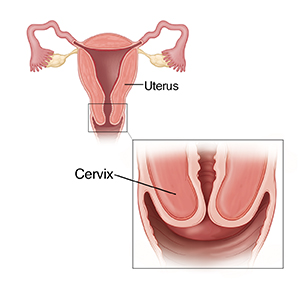Cervical Cryotherapy
Cervical cryotherapy (also called cryosurgery or cryoablation) is a procedure that removes abnormal cells from the cervix. It’s most often done in the healthcare provider's office, and it only takes a few minutes. During cryotherapy, tissue that includes the abnormal cells is frozen, thereby destroying it. The tissue that grows back is usually normal. In most cases, all abnormal cells are removed with only one treatment.

Why might I need cervical cryotherapy?
Cervical cryotherapy may be done if a Pap test and colposcopy show abnormal cells on the cervix. Here are some of the problems cervical cryotherapy treats:
-
Dysplasia. This occurs when cells in the cervix change in ways that aren’t normal. This is often caused by a sexually transmitted virus called HPV (human papillomavirus).
-
Warts (condyloma). These can grow on the cervix. These are also caused by HPV.
-
Chronic cervicitis. This is a recurring inflammation of the cervix.
What are the risks of cervical cryotherapy?
Risks of cervical cryotherapy are fairly low. They may include:
How do I get ready for cervical cryotherapy?
Cervical cryotherapy is most often an office procedure. It will be scheduled for a day when you’re not having your menstrual period. You may be asked to sign a consent form before the procedure. You may also be given special instructions, including the following:
-
Avoid sex, tampons, douching, and creams or other vaginal medicine for a few days before your procedure.
-
Take an over-the-counter pain reliever an hour before your appointment.
-
Pee before the procedure.
What happens during cervical cryotherapy?
-
You will be asked to lie on an exam table with your feet in stirrups, just as you do for a Pap test.
-
An instrument called a speculum is inserted into the vagina to hold it open.
-
A local anesthetic may be used to numb your cervix.
-
A thin probe is held on the cervix. This creates a ball of ice that freezes and kills the tissue. This step may be done a few times.
-
You will likely have cramps while the ice is touching your cervix. Tell your healthcare provider if the cramps are too uncomfortable.
-
You may feel lightheaded. This will go away when the procedure is over. You can rest on the exam table until you feel better.
What happens after cervical cryotherapy?
-
You will have thin, watery discharge after treatment. You may also have some light bleeding.
-
Use pads, not tampons, immediately after the procedure. Ask your healthcare provider when it’s OK to use tampons again.
-
The cervical tissue can bleed easily as it heals. To protect it, you may be told not to have sex, douche, or exercise for a certain amount of time.
When should I call my healthcare provider?
Call your healthcare provider if you have:
-
A fever of 100.4°F ( 38°C) or higher, or as directed by your healthcare provider
-
Abdominal cramps or pelvic pain for more than 24 hours
-
Foul-smelling discharge
-
Heavy vaginal bleeding
Follow-up care
You can probably return to your normal routine right after cervical cryotherapy. Follow your healthcare provider’s instructions while your cervix is healing. You’ll likely have a follow-up appointment 4 to 6 weeks after treatment to make sure you’re healing well. At a later visit, another Pap test or colposcopy may be done to ensure that treatment was successful.